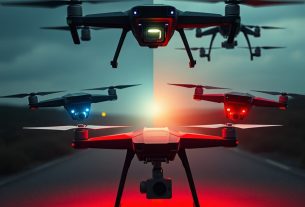In January 2024, as families across China gathered to celebrate the Lunar New Year, a spectacle unfolded on national television that captured the world’s attention: a troupe of humanoid robots, draped in crimson scarves, twirled and danced in flawless unison. For over a billion viewers, the performance was entertainment. For U.S. tech leaders, it was a wake-up call. China isn’t just dabbling in humanoid robotics—it’s positioning itself to dominate a market that could reshape industries from manufacturing to elder care. And while Tesla’s Optimus grabs headlines, Chinese companies are quietly building a playbook that combines aggressive pricing, state-backed investment, and supply chain mastery.
The question for American businesses isn’t whether humanoid robots will matter, but how China’s rapid progress could disrupt global markets—and what that means for U.S. competitiveness.
The Global Race: Why Humanoids Are More Than Sci-Fi
Humanoid robots—machines designed to mimic human movement and cognition—have long been relegated to research labs and Hollywood scripts. But advances in AI, sensor technology, and battery efficiency are turning them into viable tools. Tesla’s Optimus, Boston Dynamics’ Atlas, and startups like Figure AI (backed by Jeff Bezos and Nvidia) dominate Western conversations. Yet China’s approach is distinct: less flash, more pragmatism.
While Elon Musk predicts a $10 trillion future for Optimus, China is focused on solving immediate problems. Its aging population (which has shrunk for three consecutive years) and rising labor costs are existential challenges. Humanoids, Beijing believes, could fill gaps in factories, warehouses, and even homes. “This isn’t about replacing humans—it’s about survival,” says Brady Helwig, an economist at the U.S.-based Special Competitive Studies Project.
China’s Secret Weapon: Speed, Scale, and Subsidies
China’s strategy mirrors its electric vehicle (EV) playbook: leverage state support, optimize supply chains, and undercut competitors on price. Consider these numbers:
- 56% of global humanoid robot supply chain companies are based in China (Morgan Stanley, 2024).
- $10 billion+ in government and private funding has been poured into Chinese robotics since 2021.
- $12,175: The price tag of Engine AI’s PM01 humanoid—less than half the estimated cost of Tesla’s Optimus.
“China starts with ‘good enough’ technology, then iterates rapidly,” explains Xi Ning, a robotics professor at the University of Hong Kong. Startups like Unitree and Fourier Intelligence are already testing humanoids in real-world settings, from factory floors to hospital corridors. Meanwhile, EV giants like BYD and XPeng are repurposing their manufacturing expertise to build robots at scale.
The U.S. Advantage—and Vulnerabilities
For American tech leaders, China’s progress presents both risks and opportunities.
Where the U.S. Leads:
- Core Technologies: U.S. firms dominate high-value components like AI chips (Nvidia), precision sensors, and advanced actuators. China still relies on imported semiconductors, a vulnerability exacerbated by U.S. export controls.
- Software Ecosystems: Tesla’s AI training infrastructure and Boston Dynamics’ motion-control algorithms remain unmatched.
Where China Threatens:
- Cost Innovation: Chinese firms can produce humanoids 30–50% cheaper than Western counterparts, thanks to localized supply chains and government subsidies.
- Market Hunger: With 1.4 billion people and a government eager to automate, China offers a testing ground for rapid iteration.
“The risk isn’t that China invents better robots—it’s that they flood the market with affordable models that undercut U.S. players,” warns a Silicon Valley robotics engineer who requested anonymity.
5 Strategic Insights for U.S. Businesses
- Collaborate to Compete: Partner with Chinese suppliers to access cost-effective components while safeguarding IP. Example: Tesla’s rumored collaborations with Chinese motor manufacturers.
- Focus on High-Margin Niches: U.S. firms should prioritize applications where precision and AI sophistication matter most (e.g., surgical robots, defense).
- Lobby for Policy Clarity: Washington’s restrictions on chip exports to China could backfire by accelerating Beijing’s self-reliance push. A balanced approach is critical.
- Watch the “Tesla of China”: Startups like Agibot (backed by BYD) and Unitree are ones to track. Unitree’s CEO was recently seated front-row at a meeting with President Xi Jinping—a clear signal of state support.
- Prepare for a Hybrid Future: Humanoids won’t replace workers overnight, but they’ll augment labor in sectors like logistics and healthcare. U.S. companies should pilot partnerships now.
The Geopolitical Dance: Beyond Technology
China’s robotics push isn’t just about economics—it’s geopolitical. By positioning itself as a leader in humanoids, Beijing aims to:
- Offset Western sanctions by reducing reliance on foreign tech.
- Export affordable automation to emerging markets, expanding its influence.
- Counter U.S. dominance in AI and semiconductors.
“This is the new space race,” says Zhang Dan, a robotics expert at the Hong Kong Polytechnic University. “Whoever masters humanoids will shape the rules of the next industrial era.”
The Road Ahead: Opportunities in the Tension
For American businesses, China’s rise in robotics isn’t a death knell—it’s a catalyst. The U.S. still leads in innovation, venture capital, and software ecosystems. But complacency is dangerous.
Key Takeaways for U.S. Decision-Makers:
- Invest in R&D: Double down on AI training models and energy-efficient actuators.
- Build Resilient Supply Chains: Reduce dependence on Chinese components without decoupling entirely.
- Engage with Regulators: Advocate for policies that support domestic production while allowing global collaboration.
As Unitree’s robots kickflip their way into viral fame, one thing is clear: the humanoid revolution will be shaped by both competition and collaboration. For U.S. companies, the time to act is now—before the music stops.



